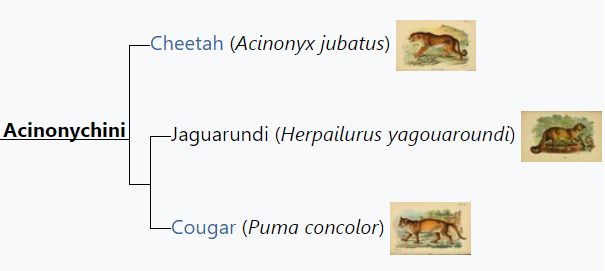The feline tribe Acinonychini contains three genera, each with one extant species: the cougar in Puma, the jaguarundi in Herpailurus, and the cheetah in Acinonyx. In addition, a handful of extinct fossil species have been found in Eurasia and the Americas. The evolutionary relationships of these cats still needs to be worked out, with the main focus being the placement of the extinct species in relation to the extant species, and where cheetahs evolved. While cheetahs and cougars are sometimes considered big cats, as felines, they are more closely related to domestic cats than they are to pantherines such as lions and leopards.
- felines
- feline
- domestic cats
1. Systematics
1.1. Extant Species
Prior to the mid-1990s, the cheetahs were placed in the monotypic subfamily Acinonychinae due to their anatomical specializations for their cursorial nature. Both the cougar and jaguarundi were classified in the genus Felis along with most of the purring cats. In the 1990s, the first molecular evidence based on mitochondrial DNA, nuclear DNA and chromosomal data found that the cheetah is nested among the purring cats, with cougars and jaguarundis their closest relatives.[1][2][3] As a result, cougars and jaguarundis were reclassified in the genus Puma and Acinonychinae is recognized as a junior synonym of Felinae.[4] More advanced molecular studies based on genomic data has found strong support for this grouping. According to the current data, acinonychins diverged from other cats around 6.7 million years ago. The cheetah was the first to diverge from Puma around 4.9 million years ago. From there the cougar and jaguarundi split off 4 million years ago.[5][6][7] In addition to the molecular work, various morphological studies that focused on the cranium have supported the relationship between Puma and Acinonyx.[8][9] While the jaguarundi is classified in the genus Puma, the species differs from cougars due to size and anatomical differences, which results in some authors placing them in their own genus, Herpailurus.[10]
Below is a phylogeny of the extant species.
| Acinonychini |
|
||||||||||||

https://handwiki.org/wiki/index.php?curid=1218089
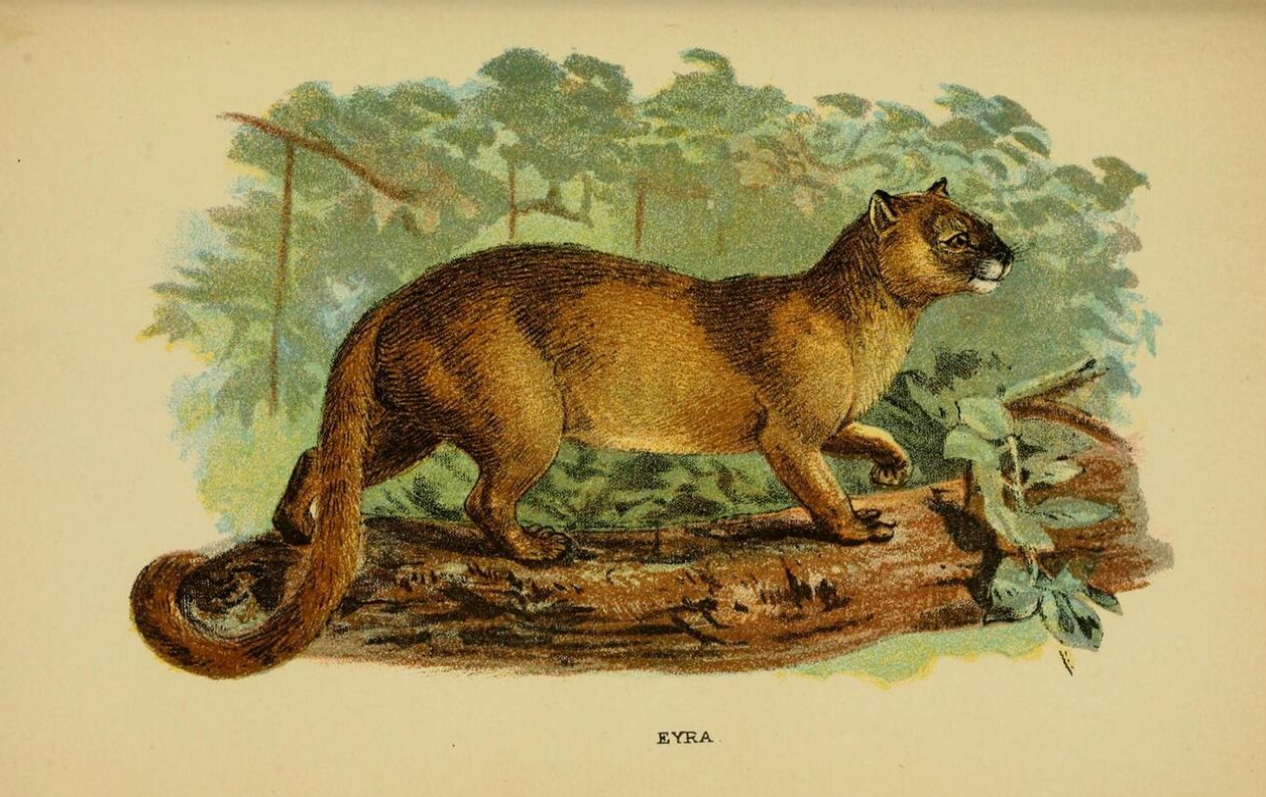
https://handwiki.org/wiki/index.php?curid=1861316

https://handwiki.org/wiki/index.php?curid=1506115
1.2. Extinct Species
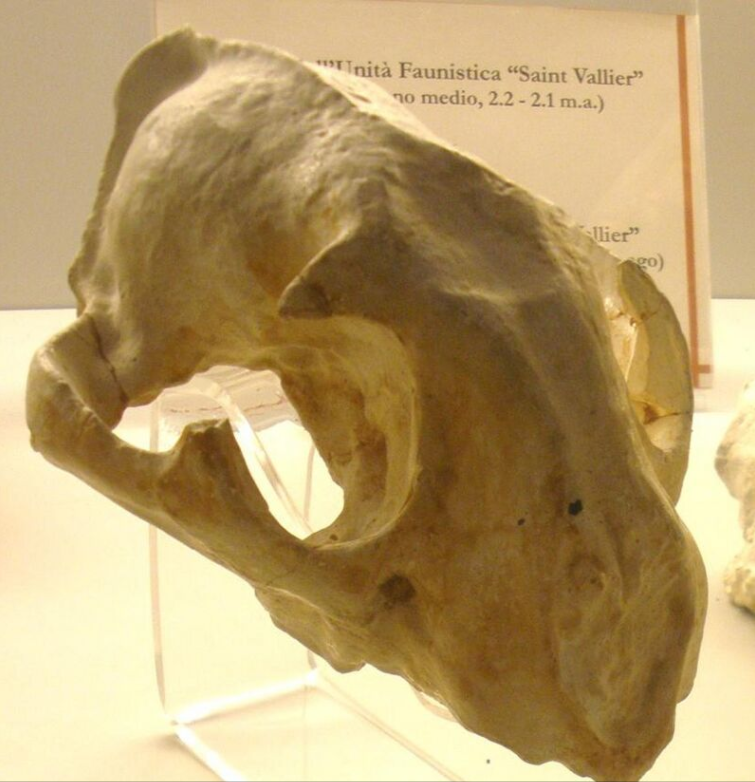
The fossil record of cheetahs and pumas is relatively well known, though there have been times of uncertainty and misplacing species in different genera. For example, the extinct Puma pardoides was originally classified as two separate species of fossil leopards, Panthera pardoides and Panthera schaubi. It became apparent that two species were the same animal, and, based on features in the skull, that the species was more closely related to the cougar.[11][12] This is also the oldest known member of the genus Puma with specimens found in the Pliocene-Pleistocene boundary lines in Western Europe.[13] This suggests that Puma first appeared in Eurasia and then have migrated at some point in the Americas to diversify into the two extant species 4 million years ago. In 2015, scientists found that the extinct Puma pumoides was an intermediate species between the cougar and the jaguarundi, being an animal that was closer to body size of the former species but anatomically closer to the latter species.[14]
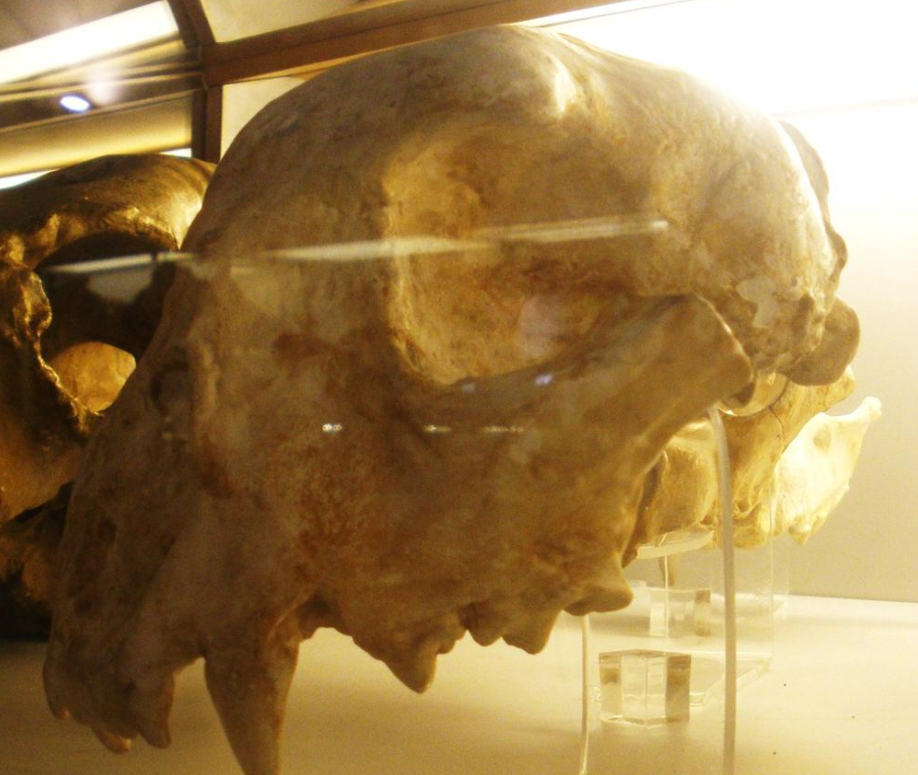
The extinct cheetah genus Sivapanthera has occasionally been considered to be a junior synonym of Acinonyx as the two genera are nearly identical, barring the robust, stout, and larger body size of Sivapanthera.[15][16] Fossil cheetahs of both Sivapanthera and Acinonyx have been found in Africa and Eurasia. The number of recognized cheetah species that existed varies among scientists from two to six, possibly eleven species.[17][18]
Perhaps the most controversial among the acinonychines are the so-called "American cheetahs" of the extinct genus Miracinonyx. There were two species of American cheetahs, M. trumani and M. inexpectatus. Initially thought to be closely related to Puma, in the 1970s researchers had placed Miracinonyx as either a subgenus of Acinonyx or a distinct genus related to cheetahs. This was based on similarities on in the skull and jaw structure, and the arrangement of the teeth. It was then postulated that cheetahs had originated from North America and migrated to Eurasia and Africa.[19] More complete specimens discovered in 1990, however, have shown that while Miracinonyx skull and body proportions do resemble cheetahs, the postcranial skeleton shows closer affinity to Puma and perhaps Sivapanthera.[20] A 2005 study examining mitochondrial DNA and re-analyzing morphology found that Miracinonyx is nested within Puma, as M. trumani and M. inexpectatus were found to be more closely to cougars than either of them to cheetahs.[21] A more comprehensive genomic study also strongly supported the convergence between Old World and American cheetahs.[22] This implies that Old World cheetahs and American cheetahs had undergone convergent evolution with each other and only pumas have colonized the Americas. Therefore, Puma is not a natural genus meaning that either Miracinonyx is a subgenus of Puma, or scientists would have to reevaluate P. pardoides as Viretailurus pardoides and P. pumoides and P. yagouaroundi as Herpailurus pumoides and H. yagouaroundi respectively in order to make Miracinonyx distinctive. Those who still support Miracinonyx being related to cheetahs question the strength of the molecular data, suggesting evidence of molecular homoplasy.[23]
Below is the current understanding of the phylogeny of acinonychin genera.
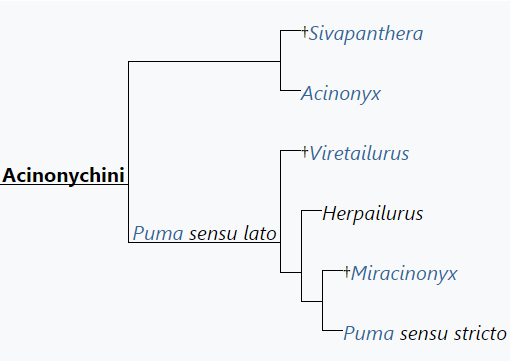
1.3. Taxonomy
Below is a listing of species and subspecies and their assignment to genera.[24][25]
- Tribe Acinonychini (Pocock, 1917)
- Genus Puma (Jardine, 1834)
- Subgenus †Viretailurus (Hemmer, 1965)
- †Puma pardoides (Owen, 1846) - Owen's panther
- Subgenus Puma (Jardine, 1834)
- Puma concolor (Linnaeus, 1771) - Cougar
- P. c. couguar (Kerr, 1792) - North American cougar
- P. c. concolor (Linnaeus, 1771) - South American cougar
- Puma concolor (Linnaeus, 1771) - Cougar
- Subgenus †Viretailurus (Hemmer, 1965)
- Genus †Miracinonyx (Adams, 1979)
- †Miracinonyx trumani (Orr, 1969)
- †Miracinonyx inexpectatus (Cope, 1895)
- Genus Herpailurus (Severtzov, 1858)
- †Herpailurus pumoides (Castellanos, 1956)[26]
- Herpailurus yagouaroundi (Geoffroy, 1803) - Jaguarundi
- Genus Acinonyx (Brookes, 1828)
- Subgenus †Sivapanthera (Kretzoi, 1929)
- †Acinonyx linxiaensis (Qiu, Deng, & Wang, 2004)
- †Acinonyx brachygnathus (Lydekker, 1884)
- †Acinonyx padhriensis (Ghaffar & Akhtar, 2004)
- †Acinonyx potens (Pilgrim, 1932)
- †Acinonyx pleistocaenicus (Zdansky, 1925)
- †Acinonyx arvernensis (Croizet & Jobert, 1828)
- †Acinonyx pardinensis (Croizet & Jobert, 1828) - Giant cheetah
- Subgenus Acinonyx (Brookes, 1828)
- †Acinonyx aicha (Geraads, 1997)
- †Acinonyx intermedius (Thenius, 1954)
- Acinonyx jubatus (Schreber, 1775) - Cheetah
- A. j. hecki (Hilzheimer, 1913) - Northwest African cheetah
- A. j. jubatus (Schreber, 1775) - Southeast African cheetah
- A. j. soemmeringii (Fitzinger, 1855) - Sudan cheetah
- A. j. venaticus (Griffith, 1821) - Asiatic cheetah
- Subgenus †Sivapanthera (Kretzoi, 1929)
- Genus Puma (Jardine, 1834)
References
- Janczewski, D. N., Modi, W. S., Stephens, J. C., & O'Brien, S. J. (1995). Molecular evolution of mitochondrial 12S RNA and cytochrome b sequences in the pantherine lineage of Felidae. Molecular Biology and Evolution, 12(4), 690-707.
- Johnson, W. E., & O’Brien, S. J. (1997). Phylogenetic reconstruction of the Felidae using 16S rRNA and NADH-5 mitochondrial genes. Journal of Molecular Evolution, 44(1), S98-S116.
- Mattern, M. Y., & McLennan, D. A. (2000). Phylogeny and speciation of felids. Cladistics, 16(2), 232-253.
- Wozencraft, W. C. (1993). Order Carnivora. Mammal species of the world: a taxonomic and geographic reference, 279-348.
- Johnson, W. E., Eizirik, E., Pecon-Slattery, J., Murphy, W. J., Antunes, A., Teeling, E., & O'Brien, S. J. (2006). The late Miocene radiation of modern Felidae: a genetic assessment. Science, 311(5757), 73-77.
- Culver, M. (2009). Lessons and insights from evolution, taxonomy, and conservation genetics. Cougar: ecology and conservation, 27-40.
- Li, G., Davis, B., Eizirik, E., & Murphy, W. (2015). Phylogenomic evidence for ancient hybridization in the genomes of living cats (Felidae). Genome research, gr-186668.
- Salles, L. O. (1992). Felid phylogenetics: extant taxa and skull morphology (Felidae, Aeluroidea). Amer. museum Novitates.
- Segura, V., Prevosti, F., & Cassini, G. (2013). Cranial ontogeny in the Puma lineage, Puma concolor, Herpailurus yagouaroundi, and Acinonyx jubatus (Carnivora: Felidae): a three‐dimensional geometric morphometric approach. Zoological Journal of the Linnean Society, 169(1), 235-250.
- Hunter, L. (2015). Wildcats of the world. Bloomsbury Press.
- Hemmer, H. 1965. Studien an “Panthera” schaubi Viret aus dem Villafranchien von Saint-Vallier (Dr me). Neues Jahrbuch fer Geologie und Paleontologie, Abhandlungen 122, 324-336.
- Hemmer, H., Kahlke, R. D., & Vekua, A. K. (2004). The Old World puma--Puma pardoides (OWEN, 1846)(Carnivora: Felidae)--In the Lower Villafranchian (Upper Pliocene) of Kvabebi (East Georgia, Transcaucasia) and its evolutionary and. Neues Jahrbuch für Geologie und Paläontologie, Abhandlungen, 233(2), 197-232.
- Cherin, M., Iurino, D. A., & Sardella, R. (2013). Earliest occurrence of Puma pardoides (Owen, 1846)(Carnivora, Felidae) at the Plio/Pleistocene transition in western Europe: New evidence from the Middle Villafranchian assemblage of Montopoli, Italy. Comptes Rendus Palevol, 12(3), 165-171.
- Chimento, N. R., Derguy, M. R., & Hemmer, H. (2014). Puma (Herpailurus) pumoides (Castellanos, 1958) nov. comb. Comentarios sistemáticos y registro fósil. Serie correlación geológica, 30(2), 92-134.
- Cherin, M., Iurino, D. A., Sardella, R., & Rook, L. (2014). Acinonyx pardinensis (Carnivora, Felidae) from the Early Pleistocene of Pantalla (Italy): predatory behavior and ecological role of the giant Plio–Pleistocene cheetah. Quaternary Science Reviews, 87, 82-97.
- Geraads, D. (2014). How old is the cheetah skull shape? The case of Acinonyx pardinensis (Mammalia, Felidae). Geobios, 47(1), 39-44.
- 邱占祥, 邓涛, & 王伴月. (2004). Early Pleistocene Mammalian Fauna from Longdan Dongxiang Gansu China. 中国古生物志, New Ser C, (27), 1-198. https://www.researchgate.net/profile/Tao_Deng/publication/281538726_Early_Pleistocene_mammalian_fauna_from_Longdan_Dongxiang_Gansu_China/links/56a36f3408aeef24c5899da1/Early-Pleistocene-mammalian-fauna-from-Longdan-Dongxiang-Gansu-China.pdf
- Spassov, N. (2011). "Acinonyx pardinensis (Croizet et Jobert) remains from the Middle Villafranchian locality of Varshets (Bulgaria) and the Plio-Pleistocene history of the cheetahs in Eurasia.". Estudios Geológicos 67 (2): 245–253. doi:10.3989/egeol.40464.187. ISSN 0367-0449. http://estudiosgeol.revistas.csic.es/index.php/estudiosgeol/article/download/842/873.
- Adams, D. B. (1979). "The cheetah: native American.". Science 205 (4411): 1155–1158. doi:10.1126/science.205.4411.1155. https://dx.doi.org/10.1126%2Fscience.205.4411.1155
- Van Valkenburgh, B., Grady, F., & Kurtén, B. (1990). The plio-pleistocene cheetah-like cat Miracinonyx inexpectatus of North America. Journal of Vertebrate Paleontology, 10(4), 434-454.
- Barnett, R., Barnes, I., Phillips, M. J., Martin, L. D., Harington, C. R., Leonard, J. A., & Cooper, A. (2005). Evolution of the extinct Sabretooths and the American cheetah-like cat. Current Biology, 15(15), R589-R590.
- Dobrynin, P., Liu, S., Tamazian, G., Xiong, Z., Yurchenko, A.A., Krasheninnikova, K., Kliver, S., Schmidt-Küntzel, A., Koepfli, K.P., Johnson, W. and Kuderna, L.F., 2015. Genomic legacy of the African cheetah, Acinonyx jubatus. Genome biology, 16(1), p.1.
- O’Brien, S. J., Koepfli, K. P., Eizirik, E., Johnson, W., Driscoll, C., Antunes, A., ... & Dobrynin, P. (2016). Response to Comment by Faurby, Werdelin and Svenning. Genome biology, 17(1), 1.
- Kitchener, A.C.; Breitenmoser-Würsten, C.; Eizirik, E.; Gentry, A.; Werdelin, L.; Wilting, A.; Yamaguchi, N. (2017). "A revised taxonomy of the Felidae: The final report of the Cat Classification Task Force of the IUCN Cat Specialist Group". Cat News (Special Issue 11). http://www.catsg.org/fileadmin/filesharing/5.Cat_News/5.3._Special_Issues/5.3.10._SI_11/CN_Special_Issue_11_Revised_taxonomy_of_the_Felidae.pdf.
- Lehnert, E. R., & Roles, E. Animal Diversity Web.
- Chimento, N. R., Derguy, M. R., & Hemmer, H. (2015). "Puma (Herpailurus) pumoides (Castellanos, 1958)(Mammalia, Felidae) del Plioceno de Argentina". Serie Correlación Geológica 30 (2). http://ppct.caicyt.gov.ar/index.php/scg/article/view/4289.

